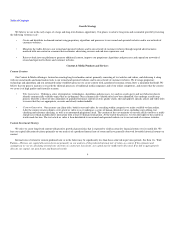Enom 2010 Annual Report Download - page 21
Download and view the complete annual report
Please find page 21 of the 2010 Enom annual report below. You can navigate through the pages in the report by either clicking on the pages listed below, or by using the keyword search tool below to find specific information within the annual report.
Table of Contents
greater financial, technical and other resources and, in some cases, the ability to combine their online marketing products with traditional offline media such
as newspapers or magazines. These companies may use these advantages to offer products and services similar to ours at a lower price, develop different
products to compete with our current offerings and respond more quickly and effectively than we can to new or changing opportunities, technologies,
standards or customer requirements. For example, both AOL and Yahoo! have access to proprietary search data which could be utilized to assist them in their
content creation processes. In addition, many of our current and potential competitors have established marketing relationships with and access to larger
customer bases. As the markets for online and social media expand, we expect new competitors, business models and solutions to emerge, some of which may
be superior to ours. Even if our platform is more effective than the products and services offered by our competitors, potential customers might adopt
competitive products and services in lieu of using our services. For all of these reasons, we may not be able to compete successfully against our current and
potential competitors.
Our Content & Media service offering primarily generates its revenue from advertising, and the reduction in spending by or loss of advertisers could
seriously harm our business.
We generated 41% and 48% of our revenue for the years ended December 31, 2009 and 2010, respectively, from advertising. One component of our
platform that we use to generate advertiser interest in our content is our system of monetization tools, which is designed to match content with advertisements
in a manner that maximizes revenue yield and end-user experience. Advertisers will not continue to do business with us if their investment in advertising with
us does not generate sales leads, and ultimately customers, or if we do not deliver their advertisements in an appropriate and effective manner. The failure of
our yield-optimized monetization technology to effectively match advertisements with our content in a manner that results in increased revenue for our
advertisers would have an adverse impact on our ability to maintain or increase our revenue from advertising.
We rely on third-party ad-providers, such as Google, to provide advertisements on our owned and operated websites and on our network of customer
websites. Even if our content is effectively matched with such ad content, we cannot assure our current advertisers will fulfill their obligations under their
existing contracts, continue to provide advertisements beyond the terms of their existing contracts or enter into any additional contracts. If any of our
advertisers, but in particular Google, decided not to continue advertising on our owned and operated websites and on our network of customer websites, we
could experience a rapid decline in our revenue over a relatively short period of time.
In addition, our customers who receive a portion of the revenue generated from advertisements matched with our content displayed on their websites,
may not continue to do business with us if our content does not generate increased revenue for them. If we are unable to remain competitive and provide value
to advertisers they may stop placing advertisements with us or with our network of customer websites, which would negatively harm our business, revenue,
financial condition and results of operations.
Lastly, we believe that advertising spending on the Internet, as in traditional media, fluctuates significantly as a result of a variety of factors, many of
which are outside of our control. These factors include:
variations in expenditures by advertisers due to budgetary constraints;
the cancellation or delay of projects by advertisers;
the cyclical and discretionary nature of advertising spending;
general economic conditions, as well as economic conditions specific to the Internet and online and offline media industry; and
19
•
•
•
•
























